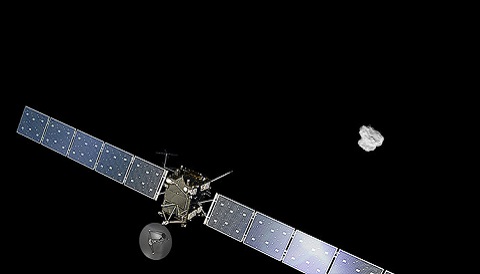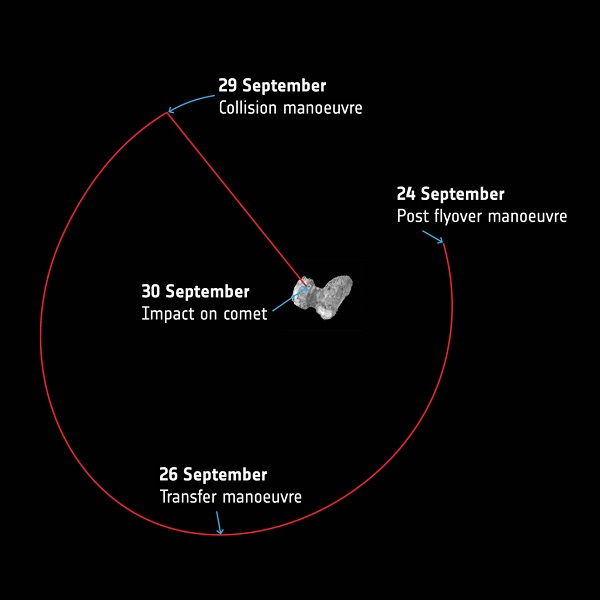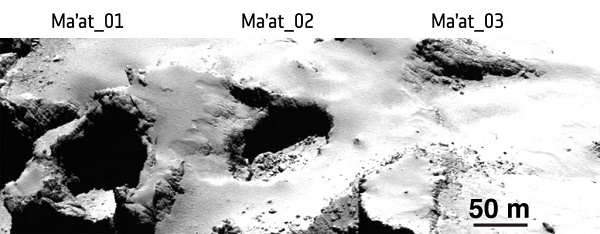Astronomy - Rosetta’s Final Days of Comet Exploration
ESA's historic Rosetta mission to explore Comet 67P will end in dramatic fashion on September 30th.

An artist's concept of Rosetta approaching Comet 67P/Churyumov–Gerasimenko.
ESA/ATG-Medialab; comet image: ESA/Rosetta/NavCam
ESA/ATG-Medialab; comet image: ESA/Rosetta/NavCam
An amazing mission of cometary exploration is about to come to a climactic end next week, as the European Space Agency's Rosetta spacecraft comes to rest on Comet 67P/Churyumov-Gerasimenko on September 30.
Launched on March 2, 2004, from Kourou, French Guiana, atop an Ariane 5 rocket, it took Rosetta 10 years to arrive at Comet 67P. This epic journey included flybys of Mars, Earth and asteroids 2867 Steins and 21 Lutetia, after which Rosetta was placed in a risky hibernation mode for several years. Reawakened on January 20, 2014, Rosetta successfully phoned home and got to work.
Thanks to Rosetta, Comet 67P is now arguably the most studied comet in the history of planetary science.
Don't Call it an Impact
Up until now, Rosetta has kept a good distance from Comet 67P, but in its last days, the final orbits of Rosetta will bring it as close as a kilometer from the surface of the comet.
Rosetta will execute its low-speed collision maneuver 20 kilometers above the comet's surface late on the evening of Thursday, September 29th. Contact is set to occur later the next day during a 20-minute window centered on 10:40 Universal Time (UT) — Comet 67P is 40 light-minutes distant, so it will take that long for ESA to receive . Rosetta is expected to come to rest on the comet at a velocity of about 1 meter per second. That's about 3.6 kilometers per hour (2.2 mph, equivalent to a slow walking pace).

Rosetta's final week orbiting Comet 67P.
ESA
ESA
“We have observations/measurements of the comet at all scales, from kilometers down to 100s of nanometers and this is giving us a wonderful insight into how the comet was created from the interstellar dust,” says project scientist Matt Taylor (ESA) “We have shown that the comet was formed from two smaller similar cometesimals that collided at low velocity.”
The Ma'at region that Rosetta is targeting is dotted with several active sink hole-style pits, measuring about 100 meters wide by 50 meters deep (imagine a football field-sized hole as deep as a typical water tower is high). Researchers plan to bring Rosetta down on a smooth plain between the Ma'at 02 and Ma'at 03 depressions, in hopes of peering inside them.

Rosetta's final home, imaged by the OSIRIS narrow angle camera from a distance of 28 kilometers.
ESA / Rosetta / MPS for OSIRIS Team / UPD / LAM / IAA / SSO / INTA / UPM / DASP / IDA
ESA / Rosetta / MPS for OSIRIS Team / UPD / LAM / IAA / SSO / INTA / UPM / DASP / IDA
Pits on Comet 67P show strange meter-sized nodules sometimes called "goosebumps." Scientists believe these lumps could be cometesimals which merged together to create the comet during the origin of the early solar system.
Instruments will continue to measure gas, dust, and plasma all the way down during Rosetta’s descent, including during the 2 kilometers closest to the comet, where some particles and ions in the coma begin accelerating toward the comet's tail. “This is something we have NEVER done with Rosetta,” Taylor says.
The mission team christened the Ma'at 02 pit as Deir el-Medina, after an ancient pit in Egypt that proved to be a modern archaeological treasure trove.
Science and the Final Days of Rosetta
The Rosetta mission provides proof that big projects spanning decades can pay off. We've learned about the dynamic processes on comets that turn them into beautiful celestial spectacles.
Rosetta has also shown that water ice on Comet 67Pcontains three times more deuterium than water on Earth, disputing primordial comets as the source of Earth's water. Rosetta did, however, discover glycine and other complex compounds on Comet 67P, offering a possible source for delivering organic compounds to early Earth.
And just within a month of the mission's end, Rosetta amazed us once again on September 5th, as the teamreleased images of the Philae lander wedged in a dark crack on the comet's surface. This answered a lingering mystery as to just why Philae had a such rough time phoning home, as it received little sunlight to charge its batteries.
Will we hear from Rosetta again, if it survives surface contact? “No, the spacecraft will be commanded to not try to re-contact Earth,” Says Taylor. “As Jim Morrison once said: 'This is the end... beautiful friend.'”
Still it's fun to wonder just what the final fate of Rosetta and Philae might be over the coming millennia. Discovered in 1969, Comet 67P orbits the Sun once every 6.44 years, its distance ranging from 1.2 to 5.7 astronomical units (a.u., the distance between Earth the Sun). Most likely, the twin lobes of Comet 67P will one day break apart, and perhaps, Philae and Rosetta will once again drift free and derelict around the Sun.
Congrats to ESA and the Rosetta team on an amazing and inspiring mission, as Rosetta joins Philae on a final strange and exotic resting place on the surface of a comet.
No comments:
Post a Comment